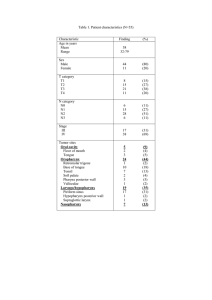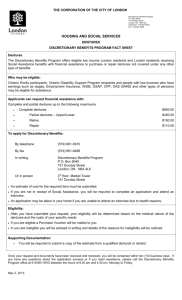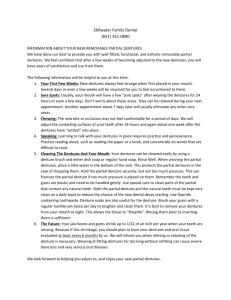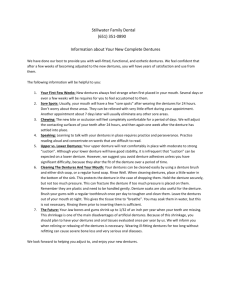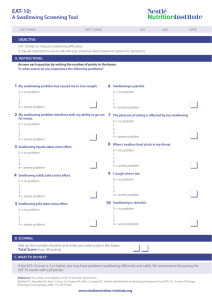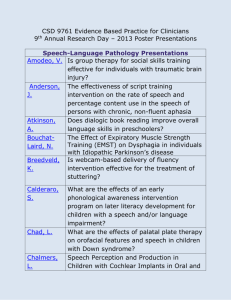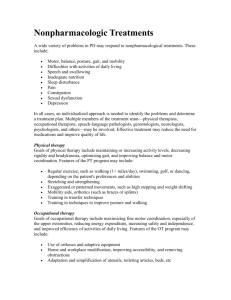KINEMATIC ANALYSIS OF LIPS MOVEMENT OF SWALLOWING ON DENTURE WEARERS... INFRARED CCD CAMERAS
advertisement
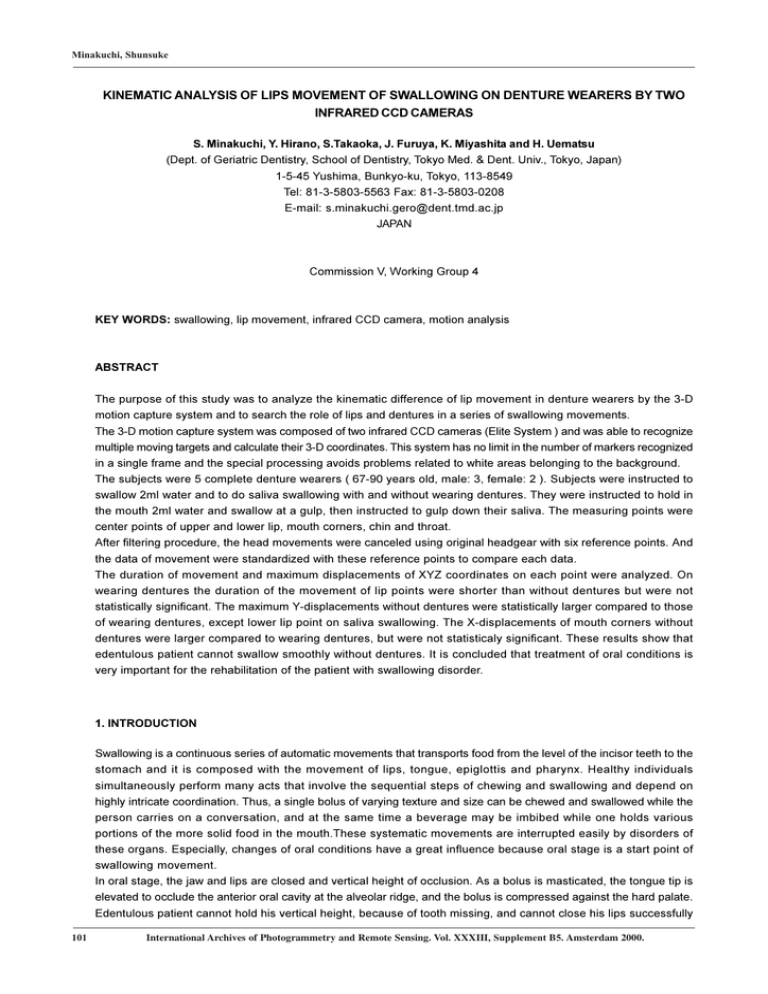
Minakuchi, Shunsuke KINEMATIC ANALYSIS OF LIPS MOVEMENT OF SWALLOWING ON DENTURE WEARERS BY TWO INFRARED CCD CAMERAS S. Minakuchi, Y. Hirano, S.Takaoka, J. Furuya, K. Miyashita and H. Uematsu (Dept. of Geriatric Dentistry, School of Dentistry, Tokyo Med. & Dent. Univ., Tokyo, Japan) 1-5-45 Yushima, Bunkyo-ku, Tokyo, 113-8549 Tel: 81-3-5803-5563 Fax: 81-3-5803-0208 E-mail: s.minakuchi.gero@dent.tmd.ac.jp JAPAN Commission V, Working Group 4 KEY WORDS: swallowing, lip movement, infrared CCD camera, motion analysis ABSTRACT The purpose of this study was to analyze the kinematic difference of lip movement in denture wearers by the 3-D motion capture system and to search the role of lips and dentures in a series of swallowing movements. The 3-D motion capture system was composed of two infrared CCD cameras (Elite System ) and was able to recognize multiple moving targets and calculate their 3-D coordinates. This system has no limit in the number of markers recognized in a single frame and the special processing avoids problems related to white areas belonging to the background. The subjects were 5 complete denture wearers ( 67-90 years old, male: 3, female: 2 ). Subjects were instructed to swallow 2ml water and to do saliva swallowing with and without wearing dentures. They were instructed to hold in the mouth 2ml water and swallow at a gulp, then instructed to gulp down their saliva. The measuring points were center points of upper and lower lip, mouth corners, chin and throat. After filtering procedure, the head movements were canceled using original headgear with six reference points. And the data of movement were standardized with these reference points to compare each data. The duration of movement and maximum displacements of XYZ coordinates on each point were analyzed. On wearing dentures the duration of the movement of lip points were shorter than without dentures but were not statistically significant. The maximum Y-displacements without dentures were statistically larger compared to those of wearing dentures, except lower lip point on saliva swallowing. The X-displacements of mouth corners without dentures were larger compared to wearing dentures, but were not statisticaly significant. These results show that edentulous patient cannot swallow smoothly without dentures. It is concluded that treatment of oral conditions is very important for the rehabilitation of the patient with swallowing disorder. 1. INTRODUCTION Swallowing is a continuous series of automatic movements that transports food from the level of the incisor teeth to the stomach and it is composed with the movement of lips, tongue, epiglottis and pharynx. Healthy individuals simultaneously perform many acts that involve the sequential steps of chewing and swallowing and depend on highly intricate coordination. Thus, a single bolus of varying texture and size can be chewed and swallowed while the person carries on a conversation, and at the same time a beverage may be imbibed while one holds various portions of the more solid food in the mouth.These systematic movements are interrupted easily by disorders of these organs. Especially, changes of oral conditions have a great influence because oral stage is a start point of swallowing movement. In oral stage, the jaw and lips are closed and vertical height of occlusion. As a bolus is masticated, the tongue tip is elevated to occlude the anterior oral cavity at the alveolar ridge, and the bolus is compressed against the hard palate. Edentulous patient cannot hold his vertical height, because of tooth missing, and cannot close his lips successfully 101 International Archives of Photogrammetry and Remote Sensing. Vol. XXXIII, Supplement B5. Amsterdam 2000. Minakuchi, Shunsuke because of loss of his lip support. So, dentures have a great influence on physiological procedure of swallowing.The purpose of this study was to analyze the kinematic difference of lip movement in denture wearers by the 3-D motion capture system and to search the role of lips in a series of swallowing movements. 2. METHOD 2.1 The Motion Capture System A 3-D optical motion capture system consists of two infrared TV cameras (Elite System, Bioengineering Technology & Systems Co., Italy). The motion capture system can recognize multiple moving targets and calculate their 3-D coordinates in real time (Fig. 1). To reduce background noises, the lens of cameras were covered with an infrared ray filter and the cameras were able to work in only infrared band. The ring strobe, which is attached to lens, emits synchronized infrared rays and the camera detects the reflection of targets. These targets are covered with reflecting membrane, semispherical shape and 2 mm in diameter. A fast processor unit for shape recognition performs cross relation processing on the image signal sent from each camera, and recognizes the circular targets. Then the processor calculates the x and y coordinates of the marker centroid. This operation allows a remarkable increase of the resolution and precision because it can eliminate noises, which were background reflections. After it, the set of the markers is identified by manual, calibrated, and the 3-D coordinates of targets are worked out (Ferrigro & Pedotti, 1985). 2.2 The Subject and the Test Foods The subjects were five complete denture wearers ( 67-90 years old, male: 3, female: 2 ). They were free from any signs and symptoms of Cranio Mandibular Dysfunction. Their dentures were made in the Department of Geriatric Dentistry, T.M.D.Univ. They were given informed consent to participate in this study. 2.3 Measuring Subjects were instructed to swallow 2ml water and to do empty swallowing with and without wearing dentures. They were instructed to hold in the mouth 2ml water and swallow at a gulp, and then they were instructed to gulp down their saliva. The measuring was done five times. Fig. 1 Elite system 2.4 Targets During swallowing, usually the head of the subject moves. To cancel head movements, the original headgear was used (Fig. 2). On the headgear, six control targets were attached in different places to adjust the movement and two rods on which two targets were attached each to indicate mandibular condyle points. The marks on subjects face were each mouth corners, chin, thyroid cartilage ( two marks ), center of upper and lower lip and just below the nose. Two marks on the thyroid cartilage were placed for the reference of swallowing movements. 2.5 Data Processing Because of the noises due to the flickers, the filtering procedure was needed before standardizing the data. It is based on the so-known Fig. 2 Headgear and targets LAMBDA (Linear Auto-regressive Model Based Derivative Assessment) algorithm3,4). The optimal cut-off frequency is not fixed, but it is determined through the estimation of the bandwidth of the signal. This leads to fit the filtering procedure to the true frequency content of the acquired kinematic data, and allows the filter to cut the noise from the International Archives of Photogrammetry and Remote Sensing. Vol. XXXIII, Supplement B5. Amsterdam 2000. 102 Minakuchi, Shunsuke Fig.3 Trace of targets( water swallowing with denture ) Fig.4 Trace of targets( without denture ) :X :Y : Z Fig. 5 Time sequential graphs of displacements of right mouth corner ( X : red, Y : green, Z : blue ). Upper shows water swallowing with denture and lower shows without denture. kinematic data. This gives the best performances especially when biomechanical data were concerned. After the filtering procedure, the head movements were canceled using least squares. Six reference points were used for it. And the data of movement were standardized to compare each data. The standard axis on the subjects head was established by right-handed coordinate system. The axis x is from left to right, the axis y is vertical against the Campers Plane (that is often used to determine the occlusal plane which consist of each traguses and the point just below the nosewing) and the axis z is anteroposterior. The duration and direction of swallowing movement and maximum displacements of XYZ coordinates on each point was analyzed 3. RESULTS Figure 3,4 show a sample of traces of water swallowing with and without dentures. And figure 5 indicates a sample of the displacements of right mouth corner in time-sequential graph. Largest displacement was shown in Y 103 International Archives of Photogrammetry and Remote Sensing. Vol. XXXIII, Supplement B5. Amsterdam 2000. Minakuchi, Shunsuke table 1. Displacement and duration of lip movement in swallowing s a li va -s w a llo w i ng d e nture ri g ht m o uth c o rne r le ft m o uth c o rne r up p e r li p lo w e r li p t 2 .6 4 x 2 .3 6 y 3 .2 5 z 2 .5 2 t 2 .5 9 x 1 .7 1 y 3 .1 0 z 2 .2 1 t 2 .4 0 x 1 .3 4 y 3 .2 5 z 1 .3 4 t 2 .6 4 x 1 .8 8 y 4 .7 2 z 2 .5 3 ¶0 .8 8 ¶ 1 .9 0 ¶ 1 .1 4 ¶ 1 .2 0 ¶ 0 .8 6 ¶ 1 .1 7 ¶ 1 .7 7 ¶ 1 .2 6 ¶ 0 .7 3 ¶ 0 .7 4 ¶ 1 .5 7 ¶ 0 .4 3 ¶ 1 .0 2 ¶ 0 .9 5 ¶ 2 .9 0 ¶ 0 .8 1 no n-d e nture 3 .0 5 2 .2 5 6 .7 6 4 .5 1 3 .0 7 2 .6 5 7 .1 0 4 .3 1 2 .9 4 1 .5 6 7 .8 0 4 .3 0 3 .0 4 1 .5 5 6 .2 5 4 .3 7 ¶ 1 .1 3 ¶ 1 .1 9 ¶ 2 .0 8 * ¶ 1 .4 0 ¶ 1 .1 9 ¶ 1 .0 5 ¶ 1 .7 8 * ¶ 1 .3 5 ¶ 1 .0 7 ¶ 0 .3 9 ¶ 1 .9 8 * ¶ 1 .4 6 * ¶ 1 .1 4 ¶ 0 .5 4 ¶ 2 .2 2 ¶ 1 .5 5 w a te r-s w a llo w i ng d e nture 2 .6 0 1 .5 7 2 .7 6 2 .4 3 2 .5 4 1 .3 3 2 .5 6 2 .7 8 2 .4 7 1 .0 5 2 .6 1 1 .4 9 2 .4 2 1 .3 2 3 .9 3 2 .0 8 ¶ 0 .8 4 ¶ 0 .8 5 ¶ 1 .7 4 ¶ 1 .4 3 ¶ 1 .0 2 ¶ 1 .0 9 ¶ 1 .6 7 ¶ 1 .9 9 ¶ 0 .9 3 ¶ 0 .2 4 ¶ 1 .5 6 ¶ 0 .4 2 ¶ 0 .9 6 ¶ 0 .9 1 ¶ 1 .3 9 ¶ 0 .6 9 no n-d e nture 3 .1 7 2 .7 7 7 .2 1 4 .6 0 3 .0 6 2 .5 5 7 .5 3 4 .2 7 3 .1 7 2 .7 7 7 .2 1 4 .6 0 3 .0 6 2 .5 5 7 .5 3 4 .2 7 ¶ 1 .2 9 ¶ 1 .3 6 ¶ 1 .9 4 * ¶ 1 .1 8 ¶ 1 .2 1 ¶ 0 .7 5 ¶ 1 .8 0 * ¶ 1 .4 4 ¶ 1 .2 9 ¶ 1 .3 6 ¶ 1 .9 4 * ¶ 1 .1 8 * ¶ 1 .2 1 ¶ 0 .7 5 ¶ 1 .8 0 * ¶ 1 .4 4 * : Statistically different (p< .05) coordinates. On wearing dentures the duration of the movement of lip points were shorter than without dentures but were not statistically significant. The maximum Y-displacements of lower lip and chin point without dentures were larger compared to wearing dentures. There was a tendency that X-displacements of mouth corners were smaller compared to wearing dentures. 4. DISCUSSION Swallowing is a very sensitive and mechanical behavior, and causes various movements in many organs. Swallowing disorder often causes aspiration pneumonia in elderly people. These elderly persons often wear dentures, and the quality of dentures seems to have a great influence in swallowing. In order to make the details of these influences clear, we planned this project. Elite System is a very useful device for biomechanical measurement. The advantages of this system are follows. 1) It can measure many targets. 2) By this advantage, head movements can be canceled. 3) The targets can be measured without harm, because the targets are optically recognized. The duration of movement and maximum displacements of XYZ coordinates on each point was analyzed. On wearing dentures the duration of the movement of lip points were shorter than without dentures but were not statistically significant. In both type of swallowing and in all points, maximum Y-displacements without dentures were larger compared to those with dentures, except lower lip on saliva swallowing. The X-displacements of mouth corners were larger compared to wearing dentures but were not statistically significant. These shows that subject’s jaw closed excessively and lips were rolled into oral cavity when he didn’t wear dentures. This fact resulted from that the tongue moved posteriory to drive the bolus into the pharynx and the pressure of oral cavity decreased. The results of this study show that edentulous patient cannot swallow smoothly without dentures. It is concluded that treatment of oral conditions is very important for the rehabilitation of the patient with swallowing disorder. ACKNOWLEDGEMENTS This project was funded by Grant-in-Aid for Scientific Research ((B)(2):09470732) (The Ministry of Education, Science and Culture, Japan.) REFERENCES 1) N.H.Bass, 1997. The neurology of swallowing, Diaphagia : Diagnosis and Management [edited by] M.E.Groher – 3rd ed., Butterworth Heinemann, USA, pp 7-36. 2)Hirano Y., Minakuchi S., Sekita T.,et al , 1998. Kinematic Analysis of Lips during Mastication by Two Infrared CCD Cameras, International Archives of Photogrammetry and Remote Sensing Vol.32(B5), pp.417-420. 3) M.D.Amico, G.Ferrigno, Sep 1990. Technique for the evaluation of derivatives from noisy biomechanical displacement data using a model-based bandwidth-selection procedure. Medical & Biological Engineering & Computing, pp 407418. 4) M.D.Amico, G.Ferrigno, Mar 1992. Comparison between the more recent techniques for smoothing and derivative assessment in biomechanics, Medical & Biological Engineering & Computing, pp193-204. International Archives of Photogrammetry and Remote Sensing. Vol. XXXIII, Supplement B5. Amsterdam 2000. 104
